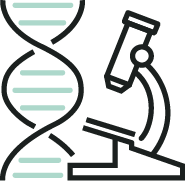
The HessMaps™ Diagnostic Platform
New Diagnostic Source
Disease development, including tumor progression, is a sequence of biological events involving genetic changes not only in cancer cells, but also in the subject’s physiology. Both of these can be traced using the ubiquitous, constantly circulating, physiologically dynamic system – platelets.
Physiologically Dynamic System
The constantly changing platelet protein landscape captures protein signatures related to:
early cancer diagnosis
tissue response to tumor progression and invasion
metastatic growth
response to therapeutic agents
Cancer isn’t a disease one gets… it’s a disease one develops.
Evolution Of Cancer Understanding
1860 - 1960
Investigational Target: Cells
Diagnostic Tools: Touch, Biopsy
Therapies: Surgery, Removal
1960 - 1990
Investigational Target: Genes
New Tools: Imaging (MRI, X-Ray, CAT)
New Therapies: Chemical, Radiation
1990 - 2012
Investigational Target: Genomics
New Tools: Gene Panels
New Therapies: Targeted Chemicals, Immunotherapy
2012 - Present
Investigational Target: Physiology (Large Biological Systems)
New Tools: Tumor and Host targets
New Therapies: Combination Therapies
HessMaps™ diagnose cancers earlier and with greater certainty than other diagnostic methods
The Early Bird…
Early Cancer detection today is limited by the diagnostic limitations of clinically available methods and the uncertain statistical probability of early cancer progression. Although many early cancers will never progress, there has not been a clinical methodology to identify those that will… Until Now.
Stimulators and Inhibitors
Hessian’s HessMap™ is the first diagnostic which recognizes that tumor growth is the result of a disturbance in the natural balance of stimulators and inhibitors of growth and tissue invasion. Recognizing cancer’s escape from dormancy is caused by either an increase in stimulators or a decrease in inhibitors. HessMaps™ track the balance of stimulators and inhibitors to define whether the tumor will grow or remain dormant.
HessMap™ Science
Platelets are first responders to injury and wounds
They carry a highly responsive and continuously changing “first response cargo” of stimulators and inhibitors of angiogenesis for localized new blood vessel development and tissue reconstruction - VEGF, bFGF, and PDGF .
As tissue reconstruction advances, the amount and type of stimulators and inhibitors in the platelet cargo changes.
To platelets, cancer is a wound.
Proteins released as a wound heals
Uncovering the Great Escape
HessMaps™ expose proteins relevant to identifying the ‘escape from tumor dormancy’….i.e., becoming malignant. Below shows how the sequestration of basic fibroblast growth factor (bFGF) in platelets can be an early marker of tumor becoming aggressive (i.e. signal an escape from dormancy). This clone of human tumor xenograft is known to require an average of 131 days to become palpable, i.e. reach a tumor size of 200-300 mm3. In this study, platelet associated bFGF detected the escape from dormancy at 60 days and in 2/5 mice and it detected early sign of tumor growth in at 32 days. All of the tumors were palpable by 130 days.
Plasma Vs. Platelets
Historically, plasma and serum have been the principle diagnostic sources for circulating indicators of early cancer . Yet, in normal physiological conditions, circulating indicators tend to quickly degrade and clear through kidneys or the liver because of proteases in plasma and serum. Conversely, Platelets α-granules circulate and protect protein cargo. When compared to genomic tests, measurement of platelet sequestered proteins provides a more robust, reliable and earlier picture of changes in the patient’s physiology.
The HessMap™ Report
Our Revolutionary HessMap™ Report is a robust disease profiling statement.
Shows the entire cancer-relevant protein landscape rather than selected protein biomarkers.
Provides an organ and person specific platelet protein array.
Groups platelet-associated proteins by their functions and impacts. E.g. angiogenesis modulating, inflammatory, growth promoting, apoptosis inducing. etc.
Shows changes in the platelet protein landscape relevant to disease type, stage and progression.
Allows for real time evaluation of the efficacy and patient response to therapy - guiding patient treatment and clinical trial enrollment and design.
The HessMap™ Assay test is not commercially available. It will be available only to participants of Hessian Labs clinical studies.
The HessMap™ test is intended to compliment not replace US recommended guidelines for cancer screening.








